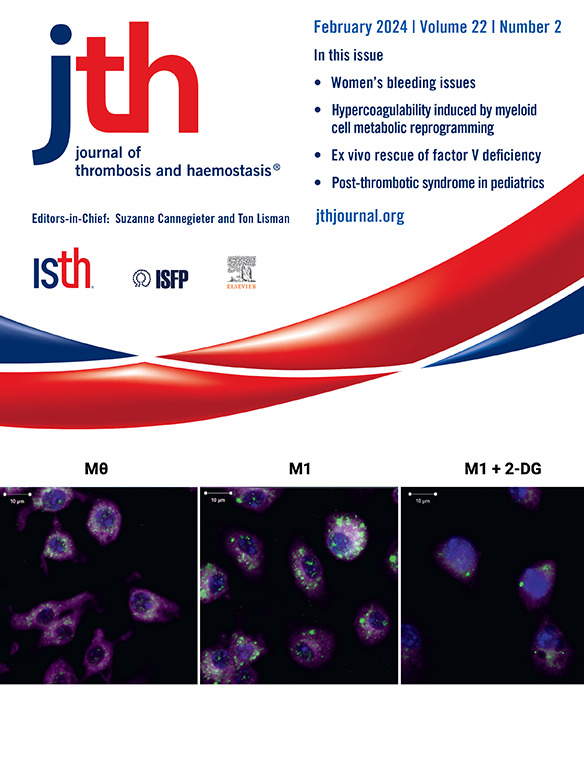治疗血浆置换治疗纤维蛋白原相关高粘度:COPLEX随机对照试验的结果。
IF 5.5
2区 医学
Q1 HEMATOLOGY
引用次数: 0
摘要
背景:治疗性血浆交换(TPE)是治疗高γ球蛋白血症引起的症状性高粘稠度的主要干预措施,但其治疗高纤维蛋白原血症引起的高粘稠度的疗效尚不清楚。目的:探讨TPE治疗新冠肺炎重症伴高纤维蛋白原血症血黏度升高患者的安全性和有效性。方法:在美国单一医疗保健系统中对COVID-19危重患者进行前瞻性随机对照试验。高纤维蛋白原血症(>800 mg/dL)或血浆粘度升高(2.3-3.5 cP)的患者被随机分为连续2天接受TPE或继续标准治疗(SOC)。结果:20例患者入组,10例接受TPE治疗,10例单独接受SOC治疗。TPE组的平均(±SEM)血浆粘度从2.35cP(±0.12)降至1.61cP(±0.03),SOC组的平均(±0.11)降至2.47cP(±0.15)。TPE后平均纤维蛋白原从934.0mg/dL(±25.1)降至359.1mg/dL(±22.5),而SOC从859.6mg/dL(±57.6)降至807.3mg/dL(±63.1)。两组间28天全因死亡率无显著差异,TPE组有2例死亡,SOC组有5例死亡(p=0.13)。未报告与TPE相关的严重安全事件。TPE显著降低炎症生物标志物(ESR、CRP)和内皮细胞活化(vWF、FVIII),但不降低止血活性(PF1.2、TAT、FM)或免疫球蛋白(IgG、IgM)水平。结论:TPE治疗COVID-19患者高纤维蛋白原血症血黏度升高安全有效。需要进一步的研究来确定TPE对患者总体预后的影响,包括与高纤维蛋白原血症相关的非covid疾病患者。本文章由计算机程序翻译,如有差异,请以英文原文为准。
Therapeutic plasma exchange for fibrinogen-associated hyperviscosity: results of the COVID-19 PLasma EXchange (COPLEX) randomized controlled trial
Background
Therapeutic plasma exchange (TPE) is the primary intervention for treating symptomatic hyperviscosity from hypergammaglobulinemia, yet its efficacy for treating hyperviscosity related to hyperfibrinogenemia is unclear.
Objectives
Define the safety and efficacy of TPE for critically ill COVID-19 patients with elevated blood viscosity from hyperfibrinogenemia.
Methods
We performed a prospective randomized controlled trial in critically ill COVID-19 patients in a single US healthcare system. Patients with hyperfibrinogenemia (>800 mg/dL) or elevated plasma viscosity (2.3-3.5 centipoise [cP]) were randomized to receive TPE on 2 consecutive days or continued standard of care (SOC).
Results
Twenty participants were enrolled, with 10 receiving TPE and 10 receiving SOC alone. Mean (±SEM) plasma viscosity decreased significantly from 2.35 cP (±0.12) to 1.61 cP (±0.03) in the TPE group and was unchanged in the SOC group (2.47 cP [±0.11] to 2.47 cP [±0.15]). Mean fibrinogen decreased from 934.0 mg/dL (±25.1) to 359.1 mg/dL (±22.5) after TPE vs from 859.6 mg/dL (±57.6) to 807.3 mg/dL (±63.1) in SOC. There was no significant difference in 28-day all-cause mortality between groups, with 2 deaths in the TPE cohort and 5 deaths in the SOC cohort (P = .13). No serious safety events related to TPE were reported. TPE significantly decreased biomarkers of inflammation (erythrocyte sedimentation rate and C-reactive protein) and endothelial activation (von Willebrand factor and factor VIII) but not hemostatic activation (prothrombin fragment 1.2, thrombin-antithrombin complex, and fibrin monomer) or immunoglobulin (IgG and IgM) levels.
Conclusion
TPE is safe and effective for normalizing elevated blood viscosity from hyperfibrinogenemia in COVID-19 patients. Additional studies are needed to determine the impact of TPE on overall patient outcomes, including in those with non–COVID-19 conditions associated with hyperfibrinogenemia.
求助全文
通过发布文献求助,成功后即可免费获取论文全文。
去求助
来源期刊
CiteScore
24.30
自引率
3.80%
发文量
321
审稿时长
1 months
期刊介绍:
The Journal of Thrombosis and Haemostasis (JTH) serves as the official journal of the International Society on Thrombosis and Haemostasis. It is dedicated to advancing science related to thrombosis, bleeding disorders, and vascular biology through the dissemination and exchange of information and ideas within the global research community.
Types of Publications:
The journal publishes a variety of content, including:
Original research reports
State-of-the-art reviews
Brief reports
Case reports
Invited commentaries on publications in the Journal
Forum articles
Correspondence
Announcements
Scope of Contributions:
Editors invite contributions from both fundamental and clinical domains. These include:
Basic manuscripts on blood coagulation and fibrinolysis
Studies on proteins and reactions related to thrombosis and haemostasis
Research on blood platelets and their interactions with other biological systems, such as the vessel wall, blood cells, and invading organisms
Clinical manuscripts covering various topics including venous thrombosis, arterial disease, hemophilia, bleeding disorders, and platelet diseases
Clinical manuscripts may encompass etiology, diagnostics, prognosis, prevention, and treatment strategies.

 求助内容:
求助内容: 应助结果提醒方式:
应助结果提醒方式:


